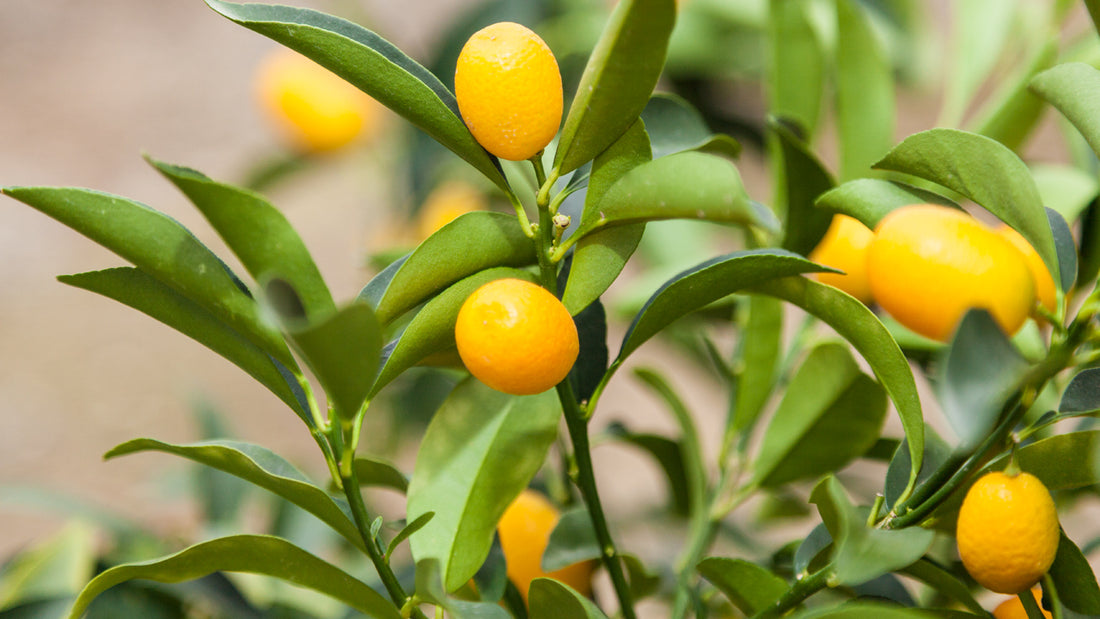What’s a Kumquat?
Cold and flu season is upon us, and it’s time to bring out the heavy arsenal of health care products: cough drops, syrups, tissues, hot soup, and kumquats. Wait, kumquats? What’s a kumquat?
Meet the Gam Gwat
Called "cumquats" in Europe, these little oval shaped orange fruits are native to the mountains of south-east China and Japan, where they were originally called by their Cantonese name “gam gwat,” meaning Golden Fruit.
Robert Fortune, a collector for the London Horticultural Society (and namesake for the kumquat’s genus Fortunella) introduced them to the west in 1846. Kumquat taste is sweet, tart, and unique in that they are the only citrus fruit with an edible peel. In the United States, they are typically found in farmers markets, grocery stores, in salads or by the handful. The seed part of the fruit is bitter but harmless, and can be either swallowed or spat out. Because of its sweet peel, it is also excellent candied or used in marmalade.
A Delicious Citrus Super Fruit
Vitamin C is well known for its ability to head off a bad cold. In the citrus family, oranges are the heavy hitter, with 53.2 mg of Vitamin C per 100 grams of fruit (that’s one large fruit, once the peel is removed). At 43.9 mg per 100 grams (73% of Recommended Daily Allowances, or RDA), kumquats have nearly as much! However, they have a lot going for them that oranges lack. This is because you eat the whole kumquat, peel and all. As with most fruits and veggies, the outer layer is where the bulk of the nutrients are. When you peel your orange and toss those skins in the compost pile, you’re throwing away all kinds of nutrients. But when you eat a kumquat, you not only get the high amounts of vitamin C and potassium in the juicy pulp, but all the nutrition of the peel too.
So what is in the kumquat peel anyway?
- It is high in fiber (100 grams of kumquats have a whopping 6.7g, or 17% of your RDA for fiber, nearly 3 times as much as an equivalent serving of orange).
- It contains abundant antioxidants, including carotenes (14 times as much as an orange!), tannins, etc.
- Many healthful essential oils are found in the peel, such as limonene, which has antimicrobial properties (naturally helping to fight those germs).
- In addition to Vitamin C, it also contains Vitamins A (25% more than an orange), Niacin (a B-Vitamin, at double the amount of an orange), and Vitamin E, all of which help remove damaging free radicals from the body and thus help to protect and heal us from infections.
- A significant amount of minerals is found in the peel, as well. 62 mg of calcium (50% more than an orange), as well as copper (more than double that of an orange), magnesium (nearly 10 times), manganese (6 times), zinc (2 times), and especially iron (11 times as much as an orange!)
Kumquat Care
Kumquats require much the same care that you would give your lemon or other citrus trees (more on that here). They make ideal potted plants, or can be grown outdoors in the proper conditions. Although there are many varieties of kumquat, the Nagami is most commonly available in the U.S. A few breeders have also begun producing crosses between kumquats and mandarin oranges (mandarinquats) or limes (you guessed it - limequats).
Kumquats are among the most cold-hardy of all citrus, withstanding temperatures down to 24F. They can be grown year-round outside in zone 9 and 10, but also make nice looking container plants for greenhouses in any zone. These thornless trees are rather slow growing, with a maximum possible height of 8 to 12 feet. However, the green leaves are easy to prune as a dwarf, so once they reach the size you want it - it is easy to keep that way. Kumquats like hot summers, which stimulate abundant white flowers. Once they are bright orange, the fruits will not get any bigger or sweeter. Harvest in the winter, just in time for the annual germ war!

